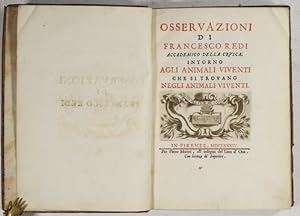osservazioni intorno agli animali viventi che si trovano negli animali viventi (1 Ergebnisse)
Produktart
- Alle Produktarten
- Bücher (1)
- Magazine & Zeitschriften
- Comics
- Noten
- Kunst, Grafik & Poster
- Fotografien
- Karten
-
Manuskripte &
Papierantiquitäten
Zustand
- Alle
- Neu
- Antiquarisch/Gebraucht
Einband
- alle Einbände
- Hardcover
- Softcover
Weitere Eigenschaften
- Erstausgabe
- Signiert
- Schutzumschlag
- Angebotsfoto
Land des Verkäufers
Verkäuferbewertung
-
Osservazioni . Intorno agli animali viventi che si trovano negli animali viventi.
Erscheinungsdatum: 1684
Anbieter: Antiq. F.-D. Söhn - Medicusbooks.Com, Marburg, Deutschland
Buch Erstausgabe
Florence: Piero Matini, 1684, 4°, (8), 253, (1) pp., Title printed in red and black with engraved vignette, 26 (2 folding) engraved plates, contemporary mottled sheep, spine gilt, upper joint repaired; fine copy. FOUNDATION OF HELMINTHOLOGY and the birth of Experimental Parasitology! First Edition! Redi was among the first of the parasitologists. He demonstrated the reproductive organs of Ascaris lumbricoides and also ascaris eggs. The results of his experiments appear in the above work, which also records his study and description of 108 different species . Two-thirds endopathic helminths, one-third exopathic parasitic insects and acarids, which Redi discovered via dissections of many type of animals, also described in detal, including leeches, earthworms, snails, slugs, cephalopods, lobsters, various fishes and an owl. (see Cole, Comparative anatomy, p. 484) "He was, further, a great man of science and a most brilliant investigator. Amongst his earliest experiments was a research on the poison of vipers and he describes how one can swallow their venom without ill effect. Only when the poison is applied to a wound does suffering, and sometimes death, follow. Redi was amongst the first to attack the doctrine of abiogenesis or spontaneous generation, which, from the time of Aristotle onwards, had held the field. This doctrine maintained that insects, worms and other animals were directly generated in mud, putrefying flesh, etc., and need have no living progenitors. Bis experiments proved for the first time that such organisms only arose from the egg of the mother fertilized by the spermatozoa of the father. At the time of his writing this was a great advance, for even at the present time there are people of repute who hold that bacteria and other microscopic organisms are generated without an antecedent parent. He made a most important series of experiments on the generation of insects. His experiments demonstrated that more than one kind of fly can come from the flesh of one kind of animal, whilst different kinds of flesh yielded the same fly. He investigated the egg-laying of flies, dissected their ovaries and proved that the appearance of a particular species of insect in flesh depended entirely on the kind of insect which had deposited the ova. He discovered that no flies originated from flesh that was kept in closed bottles whilst the flesh inside open receptacles gave rise to them. Of course he made mistakes. He at one time thought that grubs inside nuts or fruits were produced by the same "virtue" which led to the production of the particular part of the plant infected. He investigated the action of the stones in the gizzards of birds and he also added something to our knowledge of the life-history of the eel. He showed in his Osservazioni intorno agli aniniali viventi che se trovano ncgli anitnali viventi (Firenze 1684) that parasites were parasites, and not parts of the host. He also investigated the cestodes of marine fishes and suggested the use of mercury as an helminthic. In many respects he may be regarded as the father of Helminthology. He was certainly the first investigator to investigate the Helminthes with success. He investigated the tape-worms of cats and dogs and recognized at any rate in part the species Taenia crassicollis and its proglottides. He investigated the Cysticercus pisiformis from the mesentery of the hare and determined that the fluid within the "bladder-worm" did not coagulate by boiling. He described the cysticercus forms as "glandulae" or "bullae" or "hydatides pellucidae cum acumine candido non pellucido." He also recognized the head with four points (suckers). On the whole he made very distinct advances in the Science of Zoology and was highly thought of by his contemporaries and successors, such as Swammerdam, Loewenhoek and Ray." A. E. Shipley: Some Ancient Worthies in Parasitology. The Journal of Parasitology, 10/4 (Jun., 1924), pp. 182-187 "Redi .


